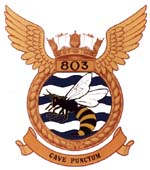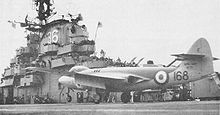| This article includes a list of general references, but it lacks sufficient corresponding inline citations. Please help to improve this article by introducing more precise citations. (November 2013) (Learn how and when to remove this message) |
| 803 Naval Air Squadron | |
|---|---|
 803 Naval Air Squadron crest 803 Naval Air Squadron crest | |
| Active | Royal Air Force 3 April 1933 – 1 April 1937 21 November 1938 - 24 May 1939 Royal Navy 24 May 1939 – 12 August 1943 15 June 1945 – 24 January 1946 Royal Canadian Navy 24 January 1946 - 1 May 1951 Royal Navy 23 November 1951 - 4 November 1955 14 January 1957 - 31 March 1958 3 June 1958 – 1 October 1966 3 July 1967 – 18 December 1969 |
| Country | |
| Branch | |
| Type | Single-seat fighter squadrons |
| Role | Fighter squadron |
| Part of | Fleet Air Arm |
| Motto(s) | Cave Punctum (Latin for 'Beware of the sting') |
| Battle honours |
|
803 Naval Air Squadron (803 NAS) was a Fleet Air Arm (FAA) naval air squadron of the United Kingdom’s Royal Navy (RN). The squadron was operational on four occasions from 1933 to 1946, subsequently transitioning to a Royal Canadian Navy squadron from 1946 to 1951. It had an additional four separate periods of activity within the Royal Navy from 1951 to 1969.
History
Interwar
803 NAS was formed on 3 April 1933 by promoting No 405 (Fleet Fighter) Flight to the status of a squadron, with nine Ospreys. In the same month it embarked on HMS Eagle for the Far East, where it remained (transferring to HMS Hermes in January 1935) until disbandment on 1 October 1937.
803 Squadron was re-formed on 21 November 1938 at RNAS Worthy Down out of 'B' Flight of No 800 Squadron. Equipped with six Ospreys and three Nimrods, then (from December 1938) six Skuas and three Nimrods, the squadron embarked in HMS Ark Royal in April 1938 as an RAF squadron but was transferred to Admiralty control on 24 May 1939.
World War II
At the outbreak of World War II, the Skuas and Rocs which formed 803 Squadron were embarked on HMS Ark Royal. Operating out of Scapa Flow, the squadron carried out anti-submarine patrols in the Northwestern Approaches (losing two Skuas in an attack on U-30 on 14 September 1939 and defending SS Fanad Head) and regular patrols off Norway (during which the squadron shot down the first German aircraft to be shot down by a British aircraft in the war, a Dornier 18, on 26 September 1939). The squadron's activities continued off Norway (though leaving her Rocs behind), operating there in April 1940 from HMS Glorious. 803 and 800 Squadrons successfully dive bombed and sank the German cruiser Königsberg at Bergen (with 800 providing five aircraft and seven crews in contrast to 803's eleven aircraft and nine crews), though an attack by 803 from Ark Royal on the German battleship Scharnhorst in June was less successful, with the loss of all but two aircraft.

803 Squadron was re-formed (with Fairey Fulmar I) in October 1940, and after that served in the Eastern Mediterranean off HMS Formidable, fighting at the Battle of Cape Matapan (shooting down two aircraft and damaging two more) and providing fighter cover for the Malta convoys and the evacuation of Crete. After HMS Formidable was damaged at Crete, 803 Squadron moved to Dekheila, where it was re-equipped with RAF Hurricanes. Next it was based in Palestine for operations against Syria from June 1941, then in August 1941 was merged into the RN Fighter Squadron (a combined unit fighting in the Western Desert).
Re-equipped again with Fairey Fulmar II in March 1942, it next operated from Ceylon against the Japanese (such as against the Easter Sunday Raid), rejoining HMS Formidable in the Indian Ocean in April. 803 Squadron then saw operations in East Africa in 1943, before absorbing 806 Squadron for army co-operation exercises. The new combined squadron was disbanded at Tanga in August 1943, and only re-formed in June 1945 ready to join 19th Carrier Air Group in the Far Eastern theatre. At the re-formation it was based at Arbroath and equipped with 25 Seafire L.IIIs, but just as it was about to ship out to the Far East in August 1945, the war came to an end.
Royal Canadian Navy
When HMS Warrior was transferred to the Royal Canadian Navy (as HMCS Warrior) in January 1946, 803 Squadron went with the ship. In May 1951, she was renamed 870 Squadron RCN, and the designation "803 Squadron" again became available to the Royal Navy.
Royal Navy


Re-formed in 1958, 803 NAS became the first FAA squadron to operate a nuclear-capable aircraft, when it received the Supermarine Scimitar F.1. (Eight years and five months later, she also became the last front-line FAA squadron to operate the Scimitar.) The squadron deployed aboard the newly rebuilt HMS Victorious, and remained attached to her air group for the next two years, after which the squadron transferred to HMS Hermes for two years; during this period, the squadron had a normal complement of eight aircraft. It then moved to HMS Ark Royal, where the greater hangar capacity meant that the squadron's standard strength could be doubled to 16 aircraft. This was achieved when 803 Squadron subsumed 800 NAS (which was due to re-equip with the Blackburn Buccaneer S.1). 803 Squadron was again disbanded on 1 October 1966. The squadron's Scimitars were transferred to RNAS Brawdy, Pembrokeshire. There, they were overhauled, before flying to Airwork, at Hurn. Subsequently, many appeared went on static display in various parts of the UK.
803 NAS was re-formed as the headquarters for the Buccaneer S.2 trials, on 3 July 1967, based at RNAS Lossiemouth. In August 1968, the squadron demonstrated the FAA's ability to reinforce forward-deployed carriers, when a flight of four Buccaneers flew from Britain to in the Indian Ocean, joining Hermes. Following a government decision to scale-down the British carrier force, 803 NAS was disbanded on 18 December 1969; her aircraft were transferred to the RAF.
Second World War battle honours
- North Sea 1939
- Norway 1940
- Libya 1940–41
- Matapan 1941
- Crete 1941
- Mediterranean 1941–44
Aircraft flown
- Hawker Osprey 1932–1944
- Hawker Nimrod 1933–?
- Blackburn Skua II Dec 1938 – Oct 1940
- Blackburn Roc I April 1939 – April 1940
- Fairey Fulmar I Oct 1940 – June 1941
- Hawker Hurricane I June 1941 – March 1942
- Hawker Sea Hurricane June 1942 – Aug 1942
- Fairey Fulmar II March 1942 – Aug 1943
- Supermarine Seafire III June 1945-end of WW2
- Supermarine Seafire F.XV Aug 1945-end of WW2
- Supermarine Attacker FB.2 January 1953 - May 1954
- Hawker Sea Hawk 1953–57
- Supermarine Scimitar 1958–1966
- Blackburn Buccaneer 1967–1969
References
Sources
External links
Categories:- 800 series Fleet Air Arm squadrons
- Air squadrons of the Royal Navy in World War II
- Military of British Ceylon
- Military units and formations of Ceylon in World War II
- Military units and formations established in 1932
- Military units and formations disestablished in 1937
- Military units and formations established in 1938
- Military units and formations disestablished in 1969